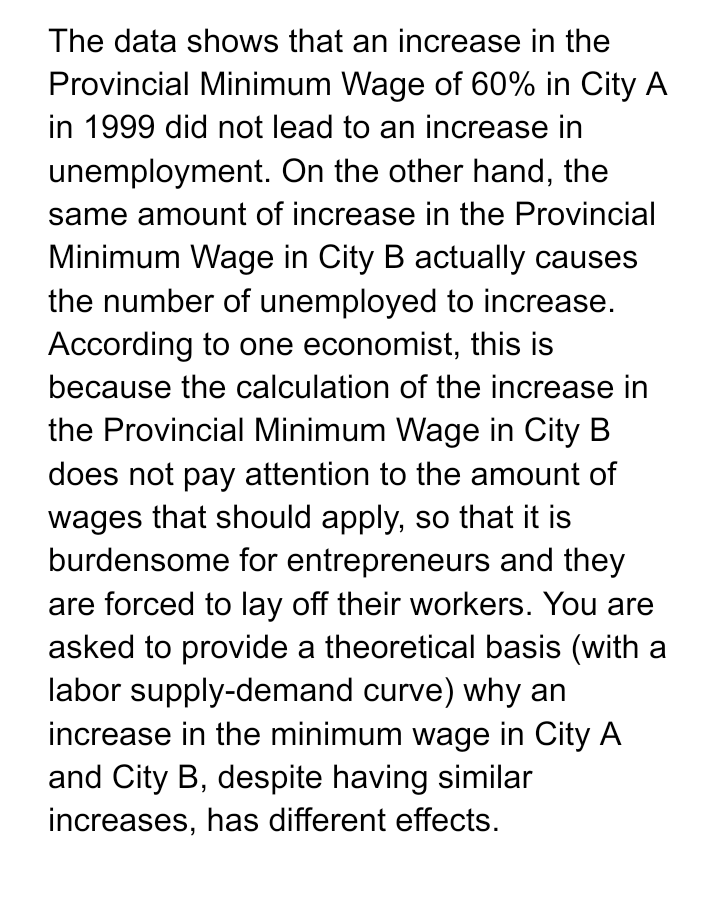The data shows that an increase in the Provincial Minimum Wage of 60% in City A in 1999 did not lead to an increase in unemployment. On the other hand, the same amount of increase in the Provincial Minimum Wage in City B actually causes the number of unemployed to increase. According to one economist, this is because the calculation of the increase in the Provincial Minimum Wage in City B does not pay attention to the amount of wages that should apply, so that it is burdensome for entrepreneurs and they are forced to lay off their workers. You are asked to provide a theoretical basis (with a labor supply-demand curve) why an increase in the minimum wage in City A and City B, despite having similar increases, has different effects.
The data shows that an increase in the Provincial Minimum Wage of 60% in City A in 1999 did not lead to an increase in unemployment. On the other hand, the same amount of increase in the Provincial Minimum Wage in City B actually causes the number of unemployed to increase. According to one economist, this is because the calculation of the increase in the Provincial Minimum Wage in City B does not pay attention to the amount of wages that should apply, so that it is burdensome for entrepreneurs and they are forced to lay off their workers. You are asked to provide a theoretical basis (with a labor supply-demand curve) why an increase in the minimum wage in City A and City B, despite having similar increases, has different effects.
Principles of Economics 2e
2nd Edition
ISBN:9781947172364
Author:Steven A. Greenlaw; David Shapiro
Publisher:Steven A. Greenlaw; David Shapiro
Chapter4: Labor And Financial Markets
Section: Chapter Questions
Problem 31P: Table 4.6 shows the amount of savings and barrowing in a market for loans lo purchase homes,...
Related questions
Question

Transcribed Image Text:The data shows that an increase in the
Provincial Minimum Wage of 60% in City A
in 1999 did not lead to an increase in
unemployment. On the other hand, the
same amount of increase in the Provincial
Minimum Wage in City B actually causes
the number of unemployed to increase.
According to one economist, this is
because the calculation of the increase in
the Provincial Minimum Wage in City B
does not pay attention to the amount of
wages that should apply, so that it is
burdensome for entrepreneurs and they
are forced to lay off their workers. You are
asked to provide a theoretical basis (with a
labor supply-demand curve) why an
increase in the minimum wage in City A
and City B, despite having similar
increases, has different effects.
Expert Solution
This question has been solved!
Explore an expertly crafted, step-by-step solution for a thorough understanding of key concepts.
Step by step
Solved in 2 steps with 1 images

Knowledge Booster
Learn more about
Need a deep-dive on the concept behind this application? Look no further. Learn more about this topic, economics and related others by exploring similar questions and additional content below.Recommended textbooks for you

Principles of Economics 2e
Economics
ISBN:
9781947172364
Author:
Steven A. Greenlaw; David Shapiro
Publisher:
OpenStax

Microeconomics: Principles & Policy
Economics
ISBN:
9781337794992
Author:
William J. Baumol, Alan S. Blinder, John L. Solow
Publisher:
Cengage Learning

Principles of Economics 2e
Economics
ISBN:
9781947172364
Author:
Steven A. Greenlaw; David Shapiro
Publisher:
OpenStax

Microeconomics: Principles & Policy
Economics
ISBN:
9781337794992
Author:
William J. Baumol, Alan S. Blinder, John L. Solow
Publisher:
Cengage Learning